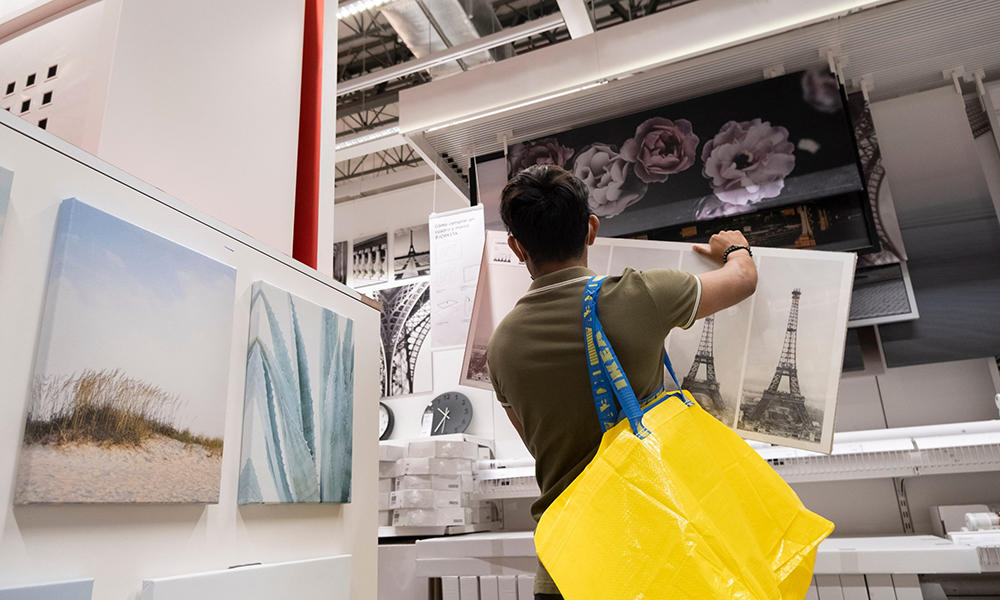
購(gòu)物者在宜家(IKEA)購(gòu)物的典型體驗(yàn)是,,要走過(guò)漫長(zhǎng)而曲折的一段路,,從一個(gè)分區(qū)來(lái)到另一個(gè)分區(qū),才可以最終抵達(dá)收銀臺(tái)(以及供應(yīng)這家家具連鎖店標(biāo)志性的瑞典肉丸的自助餐廳),。
這對(duì)一些人來(lái)說(shuō)既費(fèi)時(shí)又費(fèi)力,,為此這家零售商試圖改變門(mén)店的布局設(shè)計(jì),,以便讓顧客更容易到特定的分區(qū)購(gòu)物,。
但事實(shí)證明,購(gòu)物者其實(shí)很喜歡并希望能夠恢復(fù)迷宮般的布局,。
最近,,這家瑞典家具品牌在世界各地的一些市中心門(mén)店中嘗試采用不同的布局設(shè)計(jì),使其與那些讓購(gòu)物者可以根據(jù)自己想買的商品來(lái)隨意選擇路線的商店沒(méi)有什么兩樣,。據(jù)《華爾街日?qǐng)?bào)》(Wall Street Journal)報(bào)道,,這一新理念的提出是為了迎合臨時(shí)購(gòu)物者或者上班族的需求,這類群體可能不愿意為了購(gòu)買幾件商品而逛遍整個(gè)宜家門(mén)店,。
然而,,這家零售商的采訪和調(diào)查結(jié)果卻顯示,這種挑戰(zhàn)似乎恰恰是顧客所希冀的,。英格卡集團(tuán)(Ingka Group)的零售主管托爾加·恩居——其運(yùn)營(yíng)著宜家的眾多門(mén)店——在接受《華爾街日?qǐng)?bào)》的采訪時(shí)表示,,購(gòu)物者希望在整個(gè)購(gòu)物體驗(yàn)中能夠受到商店的引導(dǎo)。
恩居說(shuō):“我們?cè)疽詾橛捎陂T(mén)店很小,,顧客無(wú)需引導(dǎo)就可以看到全部商品,。但現(xiàn)在看來(lái),顧客顯然覺(jué)得‘不對(duì),,這是一間大商店,!’”
迷宮般布局的可貴之處還在于,它能夠讓購(gòu)物者在購(gòu)物過(guò)程中發(fā)現(xiàn)一些原來(lái)沒(méi)有意識(shí)到自己會(huì)需要的商品,。恩居稱,,顧客會(huì)在途中想起他們“三周前說(shuō)起過(guò)但如今已經(jīng)拋諸腦后”的商品。
針對(duì)新時(shí)代購(gòu)物者的設(shè)計(jì)
自選路線的門(mén)店布局只是宜家近年來(lái)為吸引新時(shí)代購(gòu)物者而嘗試的眾多布局之一,。這家零售商嘗試過(guò)開(kāi)設(shè)小型門(mén)店和專門(mén)的規(guī)劃與訂購(gòu)服務(wù)中心,,以彌補(bǔ)在線購(gòu)物體驗(yàn)的不足。另外,,宜家還在繼續(xù)嘗試以不同的理念來(lái)設(shè)計(jì)其市中心的門(mén)店——這些門(mén)店不像郊區(qū)倉(cāng)庫(kù)般的門(mén)店那樣擁有極寬敞的空間,。
目前,宜家關(guān)閉了西班牙馬德里,、中國(guó)上海和波蘭華沙等城市中顧客可以自選路線的門(mén)店,。2022年12月,由于客流量不足,,這家零售商還關(guān)閉了其在美國(guó)紐約的城區(qū)小型門(mén)店,,但在英國(guó)倫敦的哈默史密斯地區(qū)和美國(guó)舊金山的市中心開(kāi)設(shè)了類似的店面。
恩居在兩周前告訴路透社(Reuters):“我們對(duì)自己的城市策略信心十足,它對(duì)宜家在城市市場(chǎng)上的現(xiàn)有影響力具有很強(qiáng)的補(bǔ)充作用,?!彼e出了某間宜家門(mén)店的例子,該門(mén)店開(kāi)在位于瑞典斯德哥爾摩的一家購(gòu)物中心內(nèi)部,,“促使該購(gòu)物中心的客流量增加了50%”,。
英格卡集團(tuán)沒(méi)有立即回應(yīng)《財(cái)富》雜志的置評(píng)請(qǐng)求。
宜家的成功離不開(kāi)它獨(dú)特的門(mén)店布局
幾十年來(lái),,宜家一直是一個(gè)家喻戶曉的名字,。1958年,它在瑞典的艾爾姆胡爾特開(kāi)設(shè)了第一家門(mén)店,。截至今年2月,,該品牌在62個(gè)不同的市場(chǎng)擁有460家門(mén)店。
宜家的門(mén)店占地能夠達(dá)到數(shù)十萬(wàn)平方英尺(數(shù)萬(wàn)平方米),,如果采用傳統(tǒng)的布局設(shè)計(jì),,進(jìn)出可能就都得花些時(shí)間。這些門(mén)店為想要直接前往結(jié)賬的顧客提供了快捷通道,。盡管如此,,這種布局卻是宜家成功的關(guān)鍵。
宜家的家具通常會(huì)按照真實(shí)情境擺放,,而劃出不同的分區(qū)則會(huì)讓購(gòu)物者感覺(jué)仿佛在瀏覽實(shí)體目錄,。從心理層面上看,蜿蜒曲折的過(guò)道似乎可以讓購(gòu)物者渴望繼續(xù)走下去,,因?yàn)榭床坏角懊嫔唐返乃麄儾辉敢庖驗(yàn)橹型倦x開(kāi)而錯(cuò)過(guò)任何商品,。(財(cái)富中文網(wǎng))
譯者:中慧言-劉嘉歡
購(gòu)物者在宜家(IKEA)購(gòu)物的典型體驗(yàn)是,要走過(guò)漫長(zhǎng)而曲折的一段路,,從一個(gè)分區(qū)來(lái)到另一個(gè)分區(qū),,才可以最終抵達(dá)收銀臺(tái)(以及供應(yīng)這家家具連鎖店標(biāo)志性的瑞典肉丸的自助餐廳)。
這對(duì)一些人來(lái)說(shuō)既費(fèi)時(shí)又費(fèi)力,,為此這家零售商試圖改變門(mén)店的布局設(shè)計(jì),,以便讓顧客更容易到特定的分區(qū)購(gòu)物。
但事實(shí)證明,,購(gòu)物者其實(shí)很喜歡并希望能夠恢復(fù)迷宮般的布局,。
最近,這家瑞典家具品牌在世界各地的一些市中心門(mén)店中嘗試采用不同的布局設(shè)計(jì),,使其與那些讓購(gòu)物者可以根據(jù)自己想買的商品來(lái)隨意選擇路線的商店沒(méi)有什么兩樣,。據(jù)《華爾街日?qǐng)?bào)》(Wall Street Journal)報(bào)道,這一新理念的提出是為了迎合臨時(shí)購(gòu)物者或者上班族的需求,,這類群體可能不愿意為了購(gòu)買幾件商品而逛遍整個(gè)宜家門(mén)店,。
然而,,這家零售商的采訪和調(diào)查結(jié)果卻顯示,這種挑戰(zhàn)似乎恰恰是顧客所希冀的,。英格卡集團(tuán)(Ingka Group)的零售主管托爾加·恩居——其運(yùn)營(yíng)著宜家的眾多門(mén)店——在接受《華爾街日?qǐng)?bào)》的采訪時(shí)表示,,購(gòu)物者希望在整個(gè)購(gòu)物體驗(yàn)中能夠受到商店的引導(dǎo)。
恩居說(shuō):“我們?cè)疽詾橛捎陂T(mén)店很小,,顧客無(wú)需引導(dǎo)就可以看到全部商品,。但現(xiàn)在看來(lái),顧客顯然覺(jué)得‘不對(duì),,這是一間大商店,!’”
迷宮般布局的可貴之處還在于,,它能夠讓購(gòu)物者在購(gòu)物過(guò)程中發(fā)現(xiàn)一些原來(lái)沒(méi)有意識(shí)到自己會(huì)需要的商品,。恩居稱,顧客會(huì)在途中想起他們“三周前說(shuō)起過(guò)但如今已經(jīng)拋諸腦后”的商品,。
針對(duì)新時(shí)代購(gòu)物者的設(shè)計(jì)
自選路線的門(mén)店布局只是宜家近年來(lái)為吸引新時(shí)代購(gòu)物者而嘗試的眾多布局之一,。這家零售商嘗試過(guò)開(kāi)設(shè)小型門(mén)店和專門(mén)的規(guī)劃與訂購(gòu)服務(wù)中心,以彌補(bǔ)在線購(gòu)物體驗(yàn)的不足,。另外,,宜家還在繼續(xù)嘗試以不同的理念來(lái)設(shè)計(jì)其市中心的門(mén)店——這些門(mén)店不像郊區(qū)倉(cāng)庫(kù)般的門(mén)店那樣擁有極寬敞的空間。
目前,,宜家關(guān)閉了西班牙馬德里,、中國(guó)上海和波蘭華沙等城市中顧客可以自選路線的門(mén)店。2022年12月,,由于客流量不足,,這家零售商還關(guān)閉了其在美國(guó)紐約的城區(qū)小型門(mén)店,但在英國(guó)倫敦的哈默史密斯地區(qū)和美國(guó)舊金山的市中心開(kāi)設(shè)了類似的店面,。
恩居在兩周前告訴路透社(Reuters):“我們對(duì)自己的城市策略信心十足,,它對(duì)宜家在城市市場(chǎng)上的現(xiàn)有影響力具有很強(qiáng)的補(bǔ)充作用?!彼e出了某間宜家門(mén)店的例子,,該門(mén)店開(kāi)在位于瑞典斯德哥爾摩的一家購(gòu)物中心內(nèi)部,“促使該購(gòu)物中心的客流量增加了50%”,。
英格卡集團(tuán)沒(méi)有立即回應(yīng)《財(cái)富》雜志的置評(píng)請(qǐng)求,。
宜家的成功離不開(kāi)它獨(dú)特的門(mén)店布局
幾十年來(lái),宜家一直是一個(gè)家喻戶曉的名字,。1958年,,它在瑞典的艾爾姆胡爾特開(kāi)設(shè)了第一家門(mén)店。截至今年2月,,該品牌在62個(gè)不同的市場(chǎng)擁有460家門(mén)店,。
宜家的門(mén)店占地能夠達(dá)到數(shù)十萬(wàn)平方英尺(數(shù)萬(wàn)平方米),,如果采用傳統(tǒng)的布局設(shè)計(jì),進(jìn)出可能就都得花些時(shí)間,。這些門(mén)店為想要直接前往結(jié)賬的顧客提供了快捷通道,。盡管如此,這種布局卻是宜家成功的關(guān)鍵,。
宜家的家具通常會(huì)按照真實(shí)情境擺放,,而劃出不同的分區(qū)則會(huì)讓購(gòu)物者感覺(jué)仿佛在瀏覽實(shí)體目錄。從心理層面上看,,蜿蜒曲折的過(guò)道似乎可以讓購(gòu)物者渴望繼續(xù)走下去,,因?yàn)榭床坏角懊嫔唐返乃麄儾辉敢庖驗(yàn)橹型倦x開(kāi)而錯(cuò)過(guò)任何商品。(財(cái)富中文網(wǎng))
譯者:中慧言-劉嘉歡
The quintessential IKEA shopping experience features a long and winding path from one section to the next until shoppers finally reach the checkout (and the cafeteria that serves the furniture chain’s signature Swedish meatballs).
For some, it’s an exhausting and time-consuming slog, and for them the retailer tried to change the design to make it easier for people to shop from specific departments.
But it turns out that shoppers love the maze and wanted it back.
The Swedish furniture brand has recently tried out a different design at some of its downtown locations across the world, one that looks like any other store where shoppers could go any route, based on what they want to buy. According to the Wall Street Journal, the new concept was designed to cater to casual shoppers or officegoers, who may not want to go through the gauntlet of walking through an entire IKEA store to buy just a few items.
But the gauntlet is exactly what customers seemed to want, interviews and surveys conducted by the retailer revealed. Shoppers wanted to be guided by the store throughout their shopping experience, Tolga ?ncü, head of retail at Ingka Group, which operates much of IKEA’s stores, told the Journal.
“We thought we didn’t need to guide the customers because the stores are so small we thought they would see everything,” ?ncü said. “But it became very clear that [customers thought] ‘No, no, no, this is a big shop!’”
What made the maze-like format unique was also that shoppers found things along the way that they didn’t realize they needed. Customers were reminded of products they “talked about three weeks ago, but forgot,” ?ncü said.
Designing for the new-age shopper
Choose-your-path stores were just one of the many formats that IKEA has dabbled with in recent years to appeal to the new-age shopper. The retailer has experimented with smaller stores and dedicated plan-and-order locations to complement the online shopping experience. It also continues to try with different design ideas for its downtown locations, which doesn’t offer the luxury of space quite that its suburban warehouse-like locations have.
The retailer shut down stores in Madrid, Shanghai, and Warsaw where shoppers could opt for their own path. IKEA also closed its urban small store in New York last December due to low footfall, but has opened similar locations in London’s Hammersmith area and downtown San Francisco.
“We are feeling very confident in our city approach, it is very complementary to our existing IKEA presence in that market,” ?ncü told Reuters at two weeks ago. He cited the example of an IKEA store that opened inside a mall in Stockholm which has “contributed to a 50% increase in physical visitation.”
Ingka Group didn’t immediately return Fortune’s request for comment.
The store layout’s part in IKEA’s success
IKEA has been a household name for decades now. Its first store opened in ?lmhult, Sweden, in 1958. It now has 460 stores across 62 different markets as of February.
Its stores can span hundreds of thousands of square feet—and getting in and out of a store could take a while, if it’s designed the traditional way. The stores have shortcuts for those who want to head straight to billing. But the format has been key to IKEA’s success.
Furniture is often laid out in its natural setting, and categorizing different sections can make shoppers feel like they’re browsing a physical catalog. Psychologically, the winding path appears to make shoppers want to keep going since they can’t see what’s ahead and don’t want to miss anything if they leave midway through.






